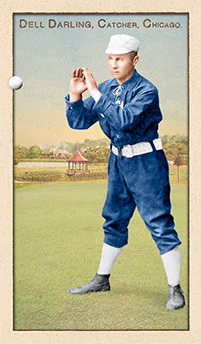
- Series: Beginnings: 1880's
- City: Chicago
- Team: White Stockings
- League: National League
Conrad Darling (1861-1904) was a modest-hitting journeyman catcher knocking around the hard-scrabble baseball towns of western Pennsylvania when The Sporting Life took note of his work following the 1886 season: “Darling was undoubtedly the most valuable man behind the bat in the International League.” Suddenly, Dell was in demand, spurning an offer from Jim Mutrie’s Giants and signing with Cap Anson’s Colts. He played well but sporadically until trying his fortune with Comiskey’s Chicago Pirates in the 1890 Players’ League. His career was in steep decline, likely due to the usual toll of catching in the big leagues. Dell played only part time for the Browns in ‘91 before hanging ‘em up. He did gain a short bit of notoriety by being implicated in a massive scheme to rob moving trains. He and other ballplayers were accused of pilfering baggage and tossing the spoils to confederates trackside. The publicity faded shortly with no indictment.
- The origin of Darling’s nickname is unknown but stayed with him through his obituary
- It was speculated that an old baseball injury contributed to Dell’s early demise
- Darling's uniform color in this card was changed from black to blue in March, 2017 to reflect recent reliable research conducted by Craig Brown and friends at Threads of Our Game. One card had been previously released featuring a black uniform.
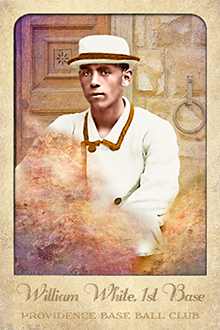
- Series: Pioneer Portraits II: 1875-1899
- City: Providence
- Team: Grays (NL)
- League: National League
William Edward White (1860-1937) has been declared by the researchers at SABR to be the most likely “first black player” in major league baseball. White, the son of a Georgia merchant and his slave, played on the Brown University team and, on June 21, 1879, substituted for an injured Joe Start at first base for the Providence Grays. White’s stint in the big leagues for this National League squad lasted only that summer solstice. With his Brown teammates cheering from the stands, White went 1-for-4, stole two bases, scored a run and recorded 12 putouts without an error, drawing rave reviews from the local papers and contributing to a 5-3 win for the title-bound Grays and a 19 year old pitcher named John Montgomery Ward. Despite the Providence Journal reporting that White would continue to play first base for the team's next series against Boston, he was replaced by regular right fielder and Hall of Famer Jim O’Rourke, who continued to man the position until Start returned. White then stepped back into society where he passed for Caucasian. This is borne out by census records showing he claimed Rhode Island birth and being of white race.
- It has been suggested that White had always passed as white, thereby escaping suspicion in the baseball world and dodging "the virulent racism prevalent in the late 19th century." This may explain in part why the true identity of the first black ballplayer in major league baseball history went largely unknown for about 125 years.
- It is likely that White is the only former slave to play major league baseball.
- White’s death resulted from a fall on Chicago’s ice. His death certificate shows him to be Caucasian, affirming this mixed-race man spent a lifetime seeking to avoid the stigma of being black in Jim Crow America.
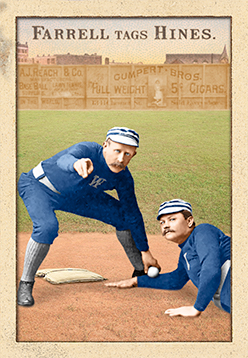
- Series: 1880s: Diamond Duos
- City: Washington, D.C.
- Team: Nationals
- League: National League
Jack Farrell:
John A. Farrell (1857-1914). Known as Moose, Farrell played 2nd base for 5 teams over 11 seasons. Jack also served as player/manager for the 1881 Providence Grays and achieved a 24-27 record before quitting as the captain. A light hitter, Jack’s defense was excellent and he either led or finished near the lead in many defensive categories for second basemen throughout his career.
- Led NL in assists with 365 in 1883
- Led NL in assists for 2B twice: 1881 & 1883
- Led NL in double plays for 2B in 1883
- Led NL in FLDG% for 2B in 1883 with .924
- Ranks 26th all-time in range factor at 2B
Paul Hines:
Paul Aloysius Hines (1855-1935). A hearing-impaired center fielder for 16 professional seasons, Hines accumulated the most hits in the first 5 years of National League history and, upon his retirement in 1891, was 3rd all-time in hits behind Cap Anson & Jim O’Rourke.
- Won baseball’s 1st Triple Crown: 1878
- May have recorded the 1st unassisted triple-play in history
- Twice won the batting title
Artist's Note:
- The uniform colors on this card were changed in April, 2017 from black to blue to reflect recent reliable research by Craig Brown & friends at Threads of Our Game. Two cards were previously released featuring black uniforms.
Auction History
Cartophilia
Old Judge Pose: 154-3
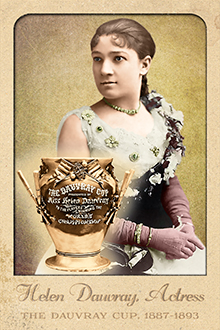
- Series: Pioneer Portraits II: 1875-1899
- League: National League
Ida Louisa Gibson (1856-1923), aka Helen Dauvray, was a child prodigy on the stage whose subsequent real estate investments made her wealthy. By 1887 her acting career was waning, but she had grown accustomed to and still longed for the acclaim accorded theatrical stars of her era. A love affair with celebrated baseball hero John Montgomery Ward was budding when Helen announced she would commission a "$500 . . . true lover's cup" to be presented annually to the players who triumphed in the “World's Championship” between the American Association and National League. In an era of shameless self-promotion, Helen's award gained traction in baseball and cast her back into the spotlight. It endured precisely as long as the romance between Monty Ward and the woman still known by many as Little Nell, the California Diamond after a long-running role of Helen's.
The Gorham Silver Co. finished the 12" tall cup on June 1, charging Helen $250. It was engraved “THE DAUVRAY CUP, Presented By Miss Helen Dauvray, to the players winning the WORLD'S CHAMPIONSHIP.” It didn't take long for some to realize that the cup would undoubtedly reside in the team owner's office, so Dauvray also commissioned medals to be given to individual players, a few of which survive in the Hall of Fame and private collections today.
Alas, the Dauvray Cup is now lost to history, having served its purpose from 1887-1893. The American Association expired following the 1890 tournament, so Miss Dauvray redirected it to become the trophy for the National League's champions. Helen had proposed that the cup become the permanent property of any club to win it three times consecutively, and the Boston Beaneaters took final possession following their third straight win in the fall of 1893. The cup was known to be in Kentucky that winter but, sadly, has disappeared since. Perhaps fittingly, the end of the cup's reign coincided with the Ward-Dauvray union's demise. Married in '87, the celebrity couple divorced in 1893.
The first recipients of the cup were not, as Dauvray may have expected, Ward's Giants. Rather, the Detroit Wolverines captured it first in a marathon 15-game series that was as much a barnstorming tour as a post-season tourney. The cup toured with the teams that inaugural year and offered Miss Dauvray the attention she sought, being displayed on the field during each game. In 1894, Helen's legacy lived on in the Temple Cup, instituted by Pirates owner William Chase Temple, to honor the winners of the NL's seven-game post-season series. It was awarded four times, last in 1897. Unlike its predecessor, the Temple Cup resides today in Cooperstown.
- Ars Longa is indebted to baseball historian John Thorn for his excellent research on the Dauvray Cup and the delightfully insouciant Miss Dauvray herself
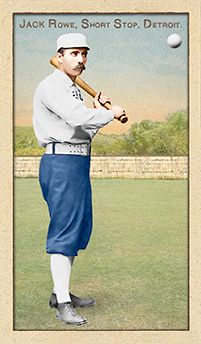
- Series: Beginnings: 1880's
- City: Detroit
- Team: Wolverines
- League: National League
John Charles Rowe (1856-1911) played a decade in the major leagues for two teams, the Buffalo Bisons and Detroit Wolverines before finishing out his career with the Alleghenys and Players’ League Bisons back in Buffalo in 1890. It was his skill at bare-handed catching in the minors that attracted the Bisons’ attention in 1878, but his September call-up impressed with the bat as well when Rowe hit .353. That debut led to a seven-year tenure in upstate NY where he gained fame as part of the “Big Four” with Dan Brouthers, Hardy Richardson and Deacon White. The quartet were formidable batsmen, but a lack of pitching doomed the franchise to mediocre results. In September ‘85 the four were sold to Detroit and remained a unit until the team folded after the ‘88 season. By 1887 Rowe was primarily a shortstop and helped the club win it all, pennant and post-season, for the high-water mark of the Wolverines. Victims of the early reserve system, Rowe and White tried unsuccessfully to return to Buffalo in ‘88 as co-owners, but were held to a sale to Pittsburgh. They did make good on their plan as a Players’ League entry in 1890 for a final year in the majors for both.
- Ran a cigar store in retirement and, per the January 1899 The Sporting Life was “one of the most contented men in Buffalo these days”




